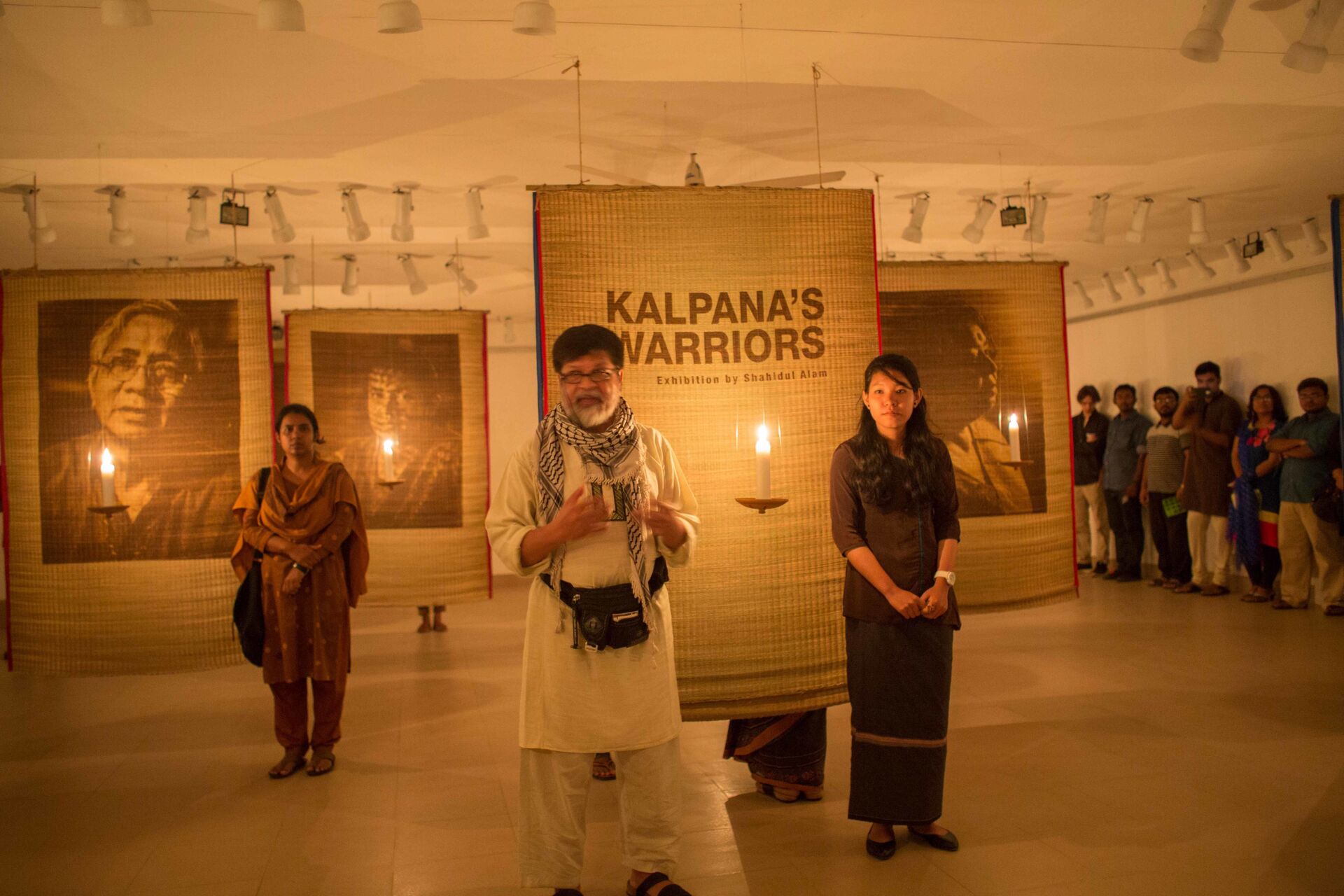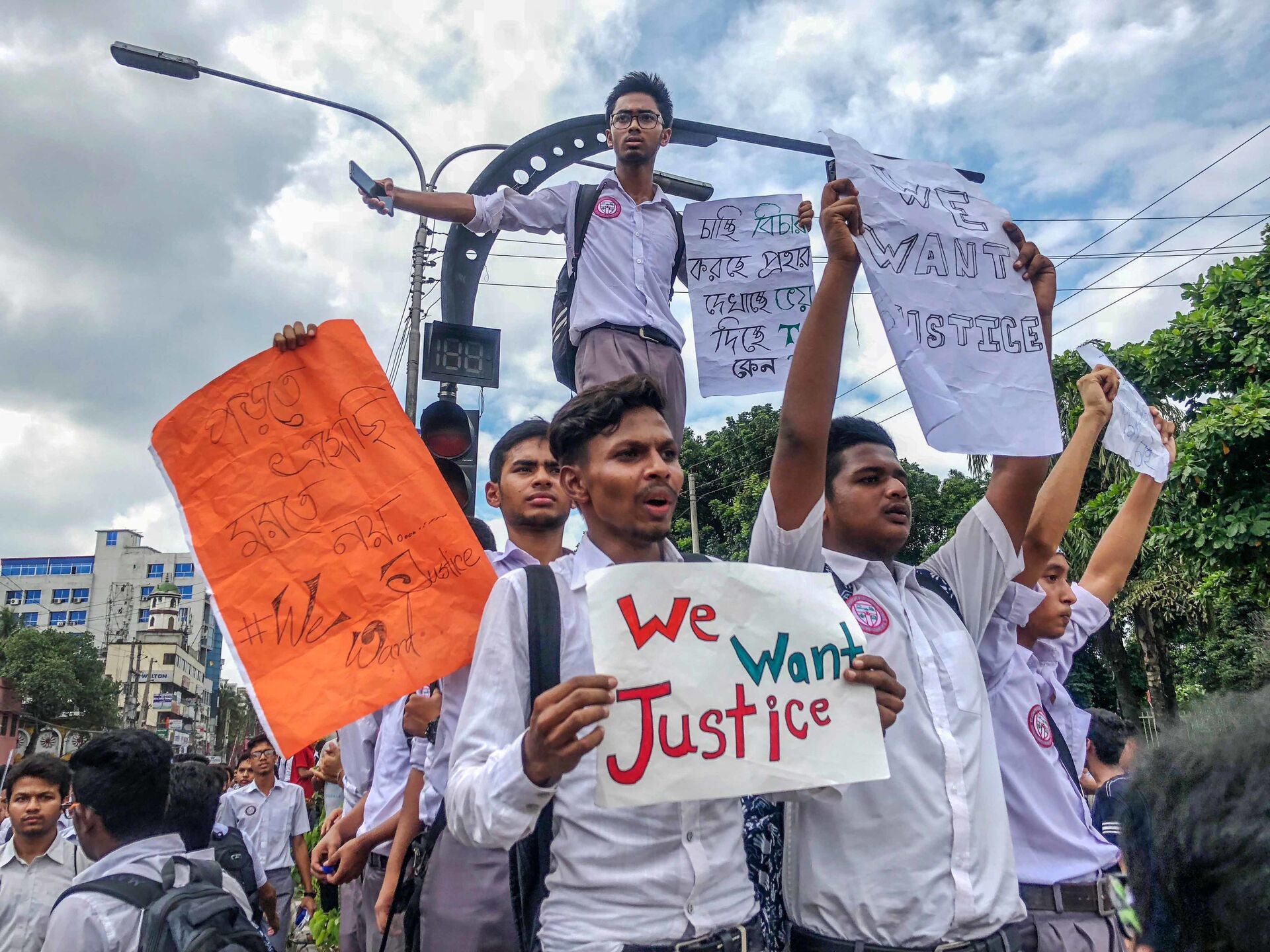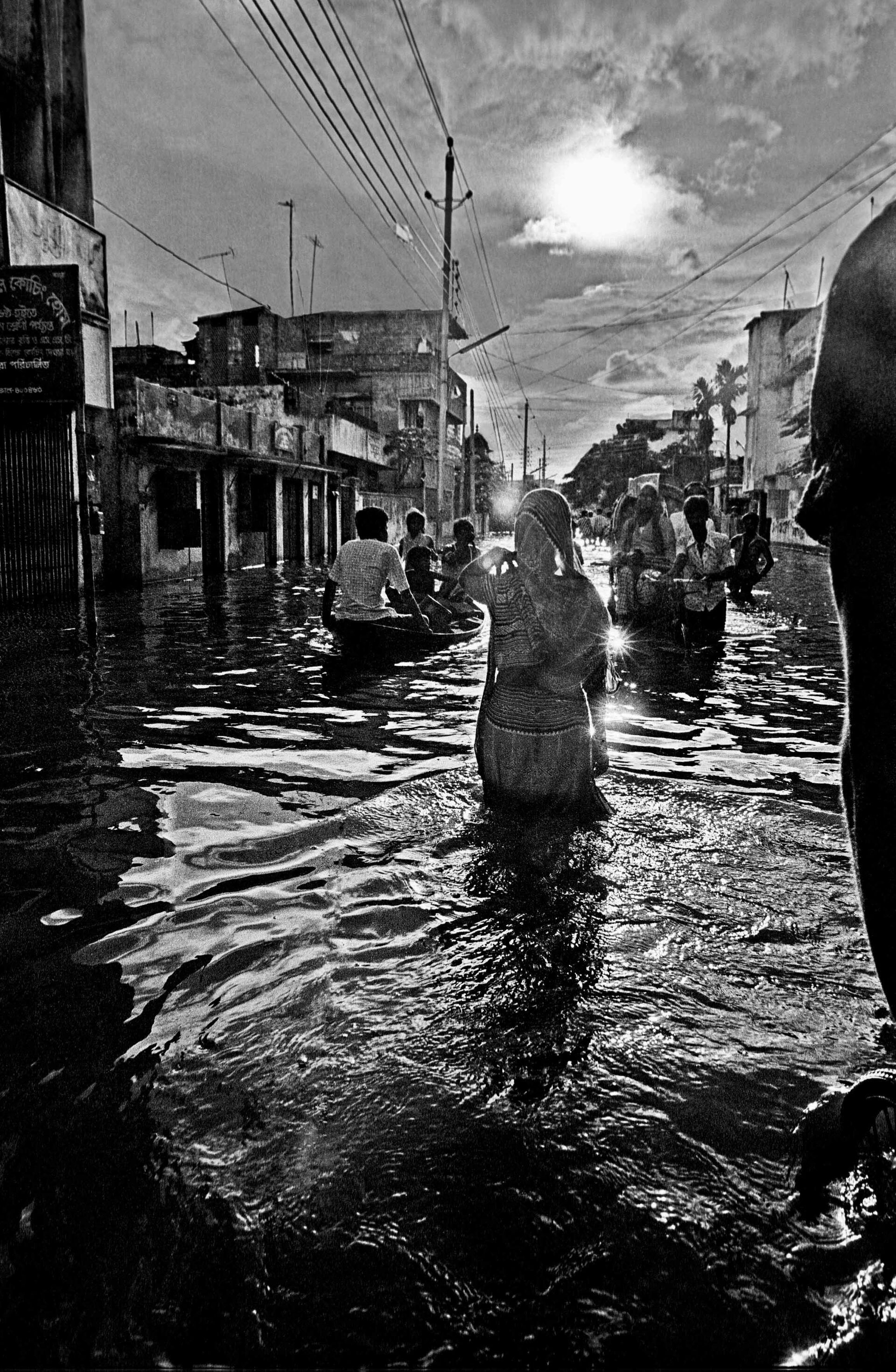
Reclaiming Political Fires in Bangladesh
Interview Shahidul Alam
Photographer, activist and educator Dr. Shahidul Alam was kidnapped from his home on 5 August 2018 by a group of officers dressed in plain clothes. He was allegedly spreading ‘false’ news through Facebook and ‘provoking’ during an Al Jazeera interview against the backdrop of student protests for better road safety taking place in Dhaka at the time. During the dark, 107-day period he spent in jail, his unjust arrest was met with an overwhelming outcry from the international community of freethinkers and human rights organisations. Students and journalists rallied relentlessly in Bangladesh for his freedom. Eventually, the Goliath that is the Bangladeshi government was forced to give in, and Shahidul’s bail was granted. The case is still ongoing, but it hasn’t deterred him from his quest for a better world. Upon his release, he was named as a Timeperson of the year, which he can add to the already sparkling list of accolades he’s achieved over the course of his career. Despite that honour, he’ll tell you that the greatest achievement that came out of this ordeal was to make transparent to the entire world the morose state of affairs in Bangladesh. His unbiased and unwavering war on oppression in Bangladesh has been ongoing for decades. I wanted to sit with the veteran warrior to borrow some of his boundless energy and also to talk about his motivations, the shifting landscape of media, the importance of being flexible and how to carry on the good fight in today’s hostile environment.
Shadman Shahid
05 nov. 2019 • 12 min
Your career as a photographer has now spanned over three decades, during which time you’ve achieved more than most photographers can hope to do in a lifetime. You were the first Asian to chair the World Press Photo; you’ve won almost every photographic award there; you founded the Drik Picture Library, which is the first international platform for Bangladeshi photographers; and you founded the photography school Pathshala, which has produced generations of photographers in Bangladesh and around the world. But before doing all this, you resided in the world of science. It was quite a leap from completing a PhD in chemistry to practising photography. Was this shift caused by an epiphany of sorts, or was it more of a gradual process?
A combination of both really. During my student days in the U.K., I got involved with the left movements that were taking place at that time. This was in the early 80s, and we were going to street rallies trying to raise public opinion. There, I began to see how photography was being used by others as part of that resistance. I began to see how photography can be used as a persuasive tool. It pointed me to the direction in which my photography might turn. The epiphany that you refer to actually relates to a little girl. I was having an exhibition in Belfast, and I was staying in town with friends. One day, I had come back from the show and as I was emptying my pockets, their five-year-old girl Karina asked me how come I had coins in my pocket? As her parents were development workers, she had been to Bangladesh; she knew how developmental agencies saved Bangladeshis as such. So her idea of a Bangladeshi was someone poor and skinny needing financial aid. The fact that a Bangladeshi had coins in his pocket didn’t fit that equation. And that was what got me thinking about the sort of social, political and cultural environment this five-year-old girl grew up in that made her incapable of seeing a Bangladeshi as anything other than an icon of poverty. Images played a big role in creating that environment. I realised that the narrative had to be changed. Because whoever controls the narrative determines the story. While White Western photographers were the people who largely told my story, it would only be a certain kind of story that was being told. I decided then that I would create a platform for local photographers. The perception and expectations of photography amongst the public needed to be taken into reckoning.

Kalpana's Warriors exhibition opening at Drik Gallery
From left to right, Taslima Akhter, Shahidul Alam and Aungmakhai Chak at the opening of the show "Kalpana's Warriors" at Drik Gallery on the 12th June 2015, marking the 19th year of the disappearance of indigenous activist and general secretary of the Hill Women's Federation, Kalpana Chakma.
©Habibul Haque/Drik

We want justice near Aarong
Students demanding justice for fellow students murdered by buses on rampage. Abdul Karim Rajib, a second-year student of Humanities department at, and Dia Khanam Meem, a first-year Science student of Shaheed Ramiz Uddin Cantonment School and College were killed on 29th July 2018, when an Uttara-bound bus of “Jabal-e-Noor Paribahan” rammed into a group of students who had been waiting on the road for transport. Road accidents are a frequent and major source of injuries and death in Bangladesh. Students throughout Dhaka city organised protest rallies, demanding safer roads and for justice. This photo was taken at the busy intersection of Manik Mia Avenue and Mirpur Road on 1st August 2018 ©Shahidul Alam/Drik/Majority World |

Abahani wedding
Guests at the wedding of the daughter of a powerful minister, held while the nation still reels from the effects of a devastating flood. Dhaka, Bangladesh. 1988. The who's who of Bangladesh was present including leading editors and journalists, but not a word was mentioned in mainstream media.
©Shahidul Alam/Drik/Majority World

Woman wading in flood
The resilience of the average Bangladeshi is remarkable. As this woman waded through the flood waters in Kamalapur to get to work, there was a photographic studio "Dreamland Photographers", which was open for business. Dhaka, Bangladesh. 1988.
©Shahidul Alam/Drik/Majority World
I think now, almost anyone can tell their own story, regardless of their nationality or creed. The world is bombarded with billions of images. The preponderance of social media means the people who make photographs and who disseminate them are very different from who used to. No power structure has the exclusive monopoly over the distribution of imagery. Their point of view can be questioned. But this has also brought with it all this talk about fake news; there is scepticism surrounding how images are made and seen. The perception and expectation of the public that you talk about has shifted. Photography can no longer be looked at as the harbinger of truth, can it?
Of course, photography can be misleading. Any powerful tool can be used in any way, and it’s who handles the tool [who] determines what it will be used for. It was 1909 when Lewis Hine said, ‘While photographs may not lie, liars may take photographs.’ I think today liars become presidents, liars become religious leaders, liars own advertising agencies. Even activists can use and abuse photography. I think what we need to do is place the weight of credibility upon the source and not the medium. Yes, photographs may or may not lie, but it is the credibility of the source that determines whether the photograph is to be believed or not. Credibility is not something that comes from above. It has to be earned and legitimised. But I think it’s positive because I don’t accept that people should believe in the content solely based on the medium it comes from. They should question on all levels. They should question the credibility and the intention of the source.
When one looks at your body of work, what stands out is your willingness to be flexible. Your strategies of using photography as a tool for resistance constantly change and expand with the needs of the time. I’m curious to know how and why your works have evolved, but let’s start in the late 1980s: the final days of the authoritarian rule of General Hussain Muhammad Ershad. The turmoil surrounding the fight for democracy in Bangladesh was at its peak, and it was closer to the beginning of your career. What shape did your methodology take during that era?
Of course, flexibility is vital. You must adapt yourself to the condition that you are in. During Ershad’s time, the way to get photographs out there was through conventional media outlets and newspapers. Therefore, the vocabulary that you used needed to be suitable for those outlets and the audience of that time. To give you a practical example, the work I had done during the last years of Ershad’s reign—I had juxtaposed images from a wedding of a minister’s daughter with the images of the floods that happened then. It was an attempt to show the divide between the rich and the poor and question the role of the government in dealing with the victims of the flood. It was a very literal sort of expression. It worked at that time. When I submitted my work for the Mother Jones photography award, I had included my open letter to the prime minister as part of the photo essay. So I was not only relying on the photographs but also political intervention. In the letter, I had mentioned the gagging of the media, discussing censorship among other things.
I remember you telling me that when you exhibited the work in 1989, the show was reviewed by the magazine that was owned by the wife of the minister you were critiquing. And I found that fascinating. Here is the minister that you question through your work, and this magazine that his wife runs was talking about it. And if I remember correctly, the review was a positive one, too. Did that surprise you or have an effect on your latter works?
What I found interesting was that the review talked about the artistry of my work, my composition, the light and the aesthetical elements. [It] never mentioned the politics. That got me thinking about how we can be put in little boxes. As if to say, ‘You can have your art but leave the politics to others.’ So I decided that my politics will be embedded within my art. Later on, for my work about the disappearance of Kalpana Chakma (the still missing human rights activist who was abducted from her home in 1996 allegedly by the Bangladesh Army), I responded to the needs of the time. Data was no longer the currency of news, and I needed to find a way to engage with people that simply went beyond providing facts. At an aesthetic level and at an intervention level. We asked questions to the silent witnesses, the people who should have been asked, whose voices should have been heard. The investigations either didn’t ask the right questions or were not giving importance to the people who knew. In the conversations between Kalpana and her abductor, the last argument was about the military setting fire to their villages. I used fire to create the imagery. The fact that she lived a very simple life was evidenced by the straw mats she slept on, so I used them as material to print the pictures on. The process of production and the material it was made on were all part of the politics of the story. So if you needed to engage with the art, you had to engage with the politics. You couldn’t separate the two.
Nowadays, there is a tremendous competition for the viewer’s attention that photographers need to face. It is a challenge to make the audience look at one’s work, let alone having a lasting effect on them. Yet you continue to make an impact on society. What tactics should photographers realise in order to remain cogent in today’s society?
I think today you have a more sophisticated audience who are used to seeing imagery in different forms through various platforms. It is a much more complex situation where international trade and international recognition are crucial aspects, and mobilising global support is of the utmost importance. Technology plays a massive part, both in terms of what the government does and how you resist. You have to create work that can play in many levels: social media, street and public exhibits, fine art galleries and international publications. You might need to tweak your work to fit the platform.
Technology is being used to repress as well. In Bangladesh, it is a risk for someone like you to carry your mobile around because the government might be listening to what you are saying through your mobile, or it has the capacity to track your movements. Western governments have been largely indifferent to this new form of repression in countries like Bangladesh and even provide the surveillance technology to these countries in some instances. Why do you think that is?
Bangladesh being allowed to get away with repression also has to do with what Bangladesh delivers to other countries. While Bangladesh can contain the Rohingya refugees and on the face of it can help out in the War on Terror, they will ignore human rights transgressions, they will ignore stolen elections, they will ignore the many, many other things that are wrong. Because it is convenient for them to have someone who delivers on their needs. What happens to Bangladeshis? They will provide lip service for that, but I don’t believe they will actually do anything.
You have always encouraged your students to be smart and not to perish in the act of resisting so that they can fight another day. But given the state of freedom of speech in today’s world, especially in the global south, or the ‘Majority World’, as you call it, do you think young photographers now can express themselves freely without being persecuted?
I have better words to define it now: ‘martyrs don’t make good reporters.’ Firstly, you have to build a network. Most young photographers nowadays understand the value of having a good network in terms of their professional career, but you also have to understand the importance of having a strong support system around you. One of the reasons I could get away with the things I said through my work—I mean the case still hangs against me, but I am out and I continue to say what I have said before—was because there was such a passionate movement internationally and in Bangladesh. We were able to do that because of the work that I have done over thirty-five years and the friends that I have made during that time. Of course, this doesn’t happen overnight, but I think each one of us needs to create that support structure. You need to build a community you can rely upon and strategic alliances that go beyond your immediate perimeter. But you also have to act smart. At the end of the day, banging away at the problem is not the answer. You have to find ways to get under their skin. You have to find cracks that you seep through, and it’s guerrilla warfare. Big power structures have more money, have more muscle, than we do, but they are also slower, less nimble and not able to get into the spaces we can get into. And I think we need to recognise our own strengths and turn it around.